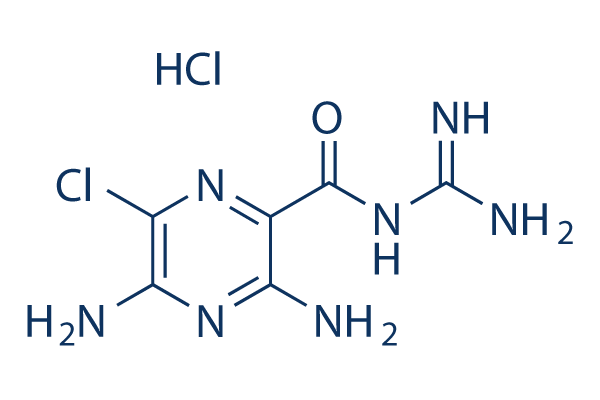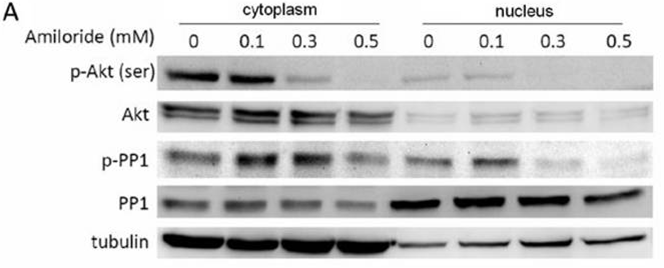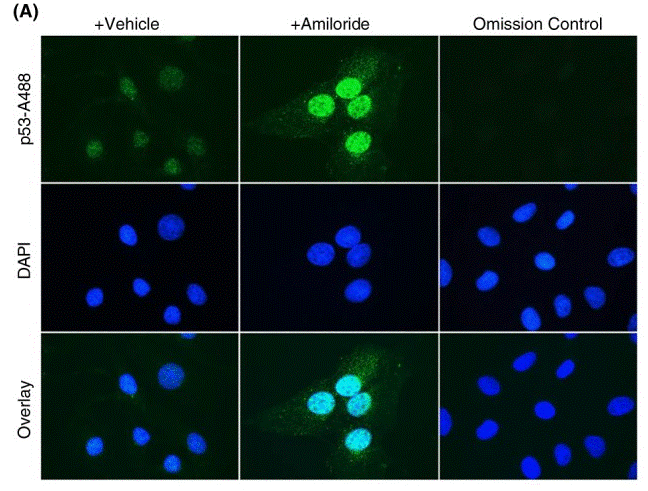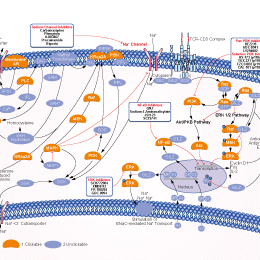
- Bioactive Compounds
- By Signaling Pathways
- PI3K/Akt/mTOR
- Epigenetics
- Methylation
- Immunology & Inflammation
- Protein Tyrosine Kinase
- Angiogenesis
- Apoptosis
- Autophagy
- ER stress & UPR
- JAK/STAT
- MAPK
- Cytoskeletal Signaling
- Cell Cycle
- TGF-beta/Smad
- DNA Damage/DNA Repair
- Compound Libraries
- Popular Compound Libraries
- Customize Library
- Clinical and FDA-approved Related
- Bioactive Compound Libraries
- Inhibitor Related
- Natural Product Related
- Metabolism Related
- Cell Death Related
- By Signaling Pathway
- By Disease
- Anti-infection and Antiviral Related
- Neuronal and Immunology Related
- Fragment and Covalent Related
- FDA-approved Drug Library
- FDA-approved & Passed Phase I Drug Library
- Preclinical/Clinical Compound Library
- Bioactive Compound Library-I
- Bioactive Compound Library-Ⅱ
- Kinase Inhibitor Library
- Express-Pick Library
- Natural Product Library
- Human Endogenous Metabolite Compound Library
- Alkaloid Compound LibraryNew
- Angiogenesis Related compound Library
- Anti-Aging Compound Library
- Anti-alzheimer Disease Compound Library
- Antibiotics compound Library
- Anti-cancer Compound Library
- Anti-cancer Compound Library-Ⅱ
- Anti-cancer Metabolism Compound Library
- Anti-Cardiovascular Disease Compound Library
- Anti-diabetic Compound Library
- Anti-infection Compound Library
- Antioxidant Compound Library
- Anti-parasitic Compound Library
- Antiviral Compound Library
- Apoptosis Compound Library
- Autophagy Compound Library
- Calcium Channel Blocker LibraryNew
- Cambridge Cancer Compound Library
- Carbohydrate Metabolism Compound LibraryNew
- Cell Cycle compound library
- CNS-Penetrant Compound Library
- Covalent Inhibitor Library
- Cytokine Inhibitor LibraryNew
- Cytoskeletal Signaling Pathway Compound Library
- DNA Damage/DNA Repair compound Library
- Drug-like Compound Library
- Endoplasmic Reticulum Stress Compound Library
- Epigenetics Compound Library
- Exosome Secretion Related Compound LibraryNew
- FDA-approved Anticancer Drug LibraryNew
- Ferroptosis Compound Library
- Flavonoid Compound Library
- Fragment Library
- Glutamine Metabolism Compound Library
- Glycolysis Compound Library
- GPCR Compound Library
- Gut Microbial Metabolite Library
- HIF-1 Signaling Pathway Compound Library
- Highly Selective Inhibitor Library
- Histone modification compound library
- HTS Library for Drug Discovery
- Human Hormone Related Compound LibraryNew
- Human Transcription Factor Compound LibraryNew
- Immunology/Inflammation Compound Library
- Inhibitor Library
- Ion Channel Ligand Library
- JAK/STAT compound library
- Lipid Metabolism Compound LibraryNew
- Macrocyclic Compound Library
- MAPK Inhibitor Library
- Medicine Food Homology Compound Library
- Metabolism Compound Library
- Methylation Compound Library
- Mouse Metabolite Compound LibraryNew
- Natural Organic Compound Library
- Neuronal Signaling Compound Library
- NF-κB Signaling Compound Library
- Nucleoside Analogue Library
- Obesity Compound Library
- Oxidative Stress Compound LibraryNew
- Plant Extract Library
- Phenotypic Screening Library
- PI3K/Akt Inhibitor Library
- Protease Inhibitor Library
- Protein-protein Interaction Inhibitor Library
- Pyroptosis Compound Library
- Small Molecule Immuno-Oncology Compound Library
- Mitochondria-Targeted Compound LibraryNew
- Stem Cell Differentiation Compound LibraryNew
- Stem Cell Signaling Compound Library
- Natural Phenol Compound LibraryNew
- Natural Terpenoid Compound LibraryNew
- TGF-beta/Smad compound library
- Traditional Chinese Medicine Library
- Tyrosine Kinase Inhibitor Library
- Ubiquitination Compound Library
-
Cherry Picking
You can personalize your library with chemicals from within Selleck's inventory. Build the right library for your research endeavors by choosing from compounds in all of our available libraries.
Please contact us at info@selleckchem.com to customize your library.
You could select:
- Antibodies
- Bioreagents
- qPCR
- 2x SYBR Green qPCR Master Mix
- 2x SYBR Green qPCR Master Mix(Low ROX)
- 2x SYBR Green qPCR Master Mix(High ROX)
- Protein Assay
- Protein A/G Magnetic Beads for IP
- Anti-Flag magnetic beads
- Anti-Flag Affinity Gel
- Anti-Myc magnetic beads
- Anti-HA magnetic beads
- Poly DYKDDDDK Tag Peptide lyophilized powder
- Protease Inhibitor Cocktail
- Protease Inhibitor Cocktail (EDTA-Free, 100X in DMSO)
- Phosphatase Inhibitor Cocktail (2 Tubes, 100X)
- Cell Biology
- Cell Counting Kit-8 (CCK-8)
- Animal Experiment
- Mouse Direct PCR Kit (For Genotyping)
- New Products
- Contact Us
Amiloride HCl
Synonyms: MK-870 HCl
Home Transmembrane Transporters Sodium Channel inhibitor - Calcium Channel inhibitor - Serine Protease inhibitor Amiloride HCl
For research use only.
Amiloride HCl is a selective T-type calcium channel blocker, an epithelial sodium channel blocker and a selective inhibitor of urokinase plasminogen activator (uPA)(Ki=7 μM).

Amiloride HCl Chemical Structure
CAS No. 2016-88-8
Purity & Quality Control
Batch:
Purity:
99.96%
99.96
Amiloride HCl Related Products
| Related Products | Camostat Mesilate EIPA A-803467 cariporide Vinpocetine Veratramine Bulleyaconi cine A | Click to Expand |
|---|---|---|
| Related Compound Libraries | FDA-approved Drug Library Natural Product Library Ion Channel Ligand Library Exosome Secretion Related Compound Library Calcium Channel Blocker Library | Click to Expand |
Signaling Pathway
Cell Data
| Cell Lines | Assay Type | Concentration | Incubation Time | Formulation | Activity Description | PMID |
|---|---|---|---|---|---|---|
| D17 | Cell viability assay | 72 h | IC50=110.66 μM | 30556178 | ||
| Abrams | Cell viability assay | 72 h | IC50=121.61 μM | 30556178 | ||
| Dharma | Cell viability assay | 72 h | IC50=148.37 μM | 30556178 | ||
| YD-10B | Function assay | 4 mM | 4 h | amiloride strongly blocked the meridianin C‐induced accumulation of vacuoles in YD-10B cells | 30246484 | |
| NS20Y | Function assay | Amiloride dose dependently inhibits the ASIC current in NS20Y cells with an IC50 of 11.04 μM | 27342076 | |||
| COS-7 | Function assay | Binding affinity for HA-tagged mutant human Adenosine A2A receptor (H250N) using [3H]-CGS-21,680 as radioligand expressed in COS-7 cells, Ki=3.28μM | 9258366 | |||
| COS-7 | Function assay | Binding affinity for HA-tagged mutant human Adenosine A2A receptor (V84L), using [3H]CGS-21680 as radioligand expressed in COS-7 cells, Ki=11.6μM | 9258366 | |||
| COS-7 | Function assay | Binding affinity for HA-tagged wild type human Adenosine A2A receptor (WT) using [3H]CGS-21680 as radioligand expressed in COS-7 cells, Ki=12μM | 9258366 | |||
| MDCK | Function assay | TP_TRANSPORTER: inhibition of TEA uptake in OCT2-expressing MDCK cells, Ki=4.7μM | 11758759 | |||
| MDCK | Function assay | TP_TRANSPORTER: inhibition of TEA uptake in OCT1-expressing MDCK cells, Ki=6.9μM | 11758759 | |||
| AP1 | Function assay | Inhibition of Amphiuma tridactylum NHE1 mutant containing TM10-12 domain of Pleuronectes americanus expressed in chinese hamster AP1 cells assessed as intracellular pHi recovery by ammonium chloride prepulse protocol, IC50=38μM | 17493937 | |||
| AP1 | Function assay | Inhibition of Pleuronectes americanus NHE1 C-terminal mutant containing TM7 domain of Amphiuma tridactylum expressed in chinese hamster AP1 cells assessed as intracellular pHi recovery by ammonium chloride prepulse protocol | 17493937 | |||
| AP1 | Function assay | Inhibition of Pleuronectes americanus NHE1 TM4 mutant containing TFFLF sequence of Amphiuma tridactylum expressed in chinese hamster AP1 cells assessed as intracellular pHi recovery by ammonium chloride prepulse protocol | 17493937 | |||
| HBE | Function assay | Inhibition of human ENaC in HBE cells by short-circuit current technique, IC50=0.22μM | 22197144 | |||
| FRT | Function assay | Inhibition of guinea pig ENaCbeta1/gamma1 expressed in FRT cells by short-circuit current technique, IC50=0.54μM | 22197144 | |||
| HBE | Function assay | Blockade of human ENaC expressed in HBE cells by short-circuit current assay, IC50=0.22μM | 22425452 | |||
| FRT | Function assay | Blockade of guinea pig ENaC expressed in FRT cells by short-circuit current assay, IC50=0.54μM | 22425452 | |||
| DAOY | qHTS assay | qHTS of pediatric cancer cell lines to identify multiple opportunities for drug repurposing: Primary screen for DAOY cells | 29435139 | |||
| A673 | qHTS assay | qHTS of pediatric cancer cell lines to identify multiple opportunities for drug repurposing: Primary screen for A673 cells | 29435139 | |||
| SK-N-MC | qHTS assay | qHTS of pediatric cancer cell lines to identify multiple opportunities for drug repurposing: Primary screen for SK-N-MC cells | 29435139 | |||
| SK-N-SH | qHTS assay | qHTS of pediatric cancer cell lines to identify multiple opportunities for drug repurposing: Primary screen for SK-N-SH cells | 29435139 | |||
| NB1643 | qHTS assay | qHTS of pediatric cancer cell lines to identify multiple opportunities for drug repurposing: Primary screen for NB1643 cells | 29435139 | |||
| A673 | qHTS assay | qHTS of pediatric cancer cell lines to identify multiple opportunities for drug repurposing: Confirmatory screen for A673 cells) | 29435139 | |||
| U-2 OS | qHTS assay | qHTS of pediatric cancer cell lines to identify multiple opportunities for drug repurposing: Confirmatory screen for U-2 OS cells | 29435139 | |||
| AP1 | Function assay | Inhibition of rat NHE1 expressed in chinese hamster AP1 cells assessed as inhibition of acid-induced 22Na+ influx by liquid scintillation spectroscopy, Ki=1μM | ChEMBL | |||
| AP1 | Function assay | Inhibition of full length human C-terminal HA-tagged human NHE5 expressed in chinese hamster AP1 cells assessed as inhibition of acid-induced 22NA+ influx by liquid scintillation spectroscopy, Ki=21μM | ChEMBL | |||
| Click to View More Cell Line Experimental Data | ||||||
Biological Activity
| Description | Amiloride HCl is a selective T-type calcium channel blocker, an epithelial sodium channel blocker and a selective inhibitor of urokinase plasminogen activator (uPA)(Ki=7 μM). | ||||||
|---|---|---|---|---|---|---|---|
| Targets |
|
| In vitro | ||||
| In vitro | Amiloride is a relatively selective inhibitor of the epithelial sodium channel (ENaC) with an IC50 (the concentration required to reach 50% inhibition of an ion channel) in the concentration range of 0.1 to 0.5 μM. Amiloride is a relatively poor inhibitor of the the Na+/H+ exchanger (NHE) with an IC50 as low as 3 μM in the presence of a low external [Na+] but as high as 1 mM in the presence of a high [Na+]. Amiloride is an even weaker inhibitor of the Na+/Ca2+ exchanger (NCX), with an IC50 of 1 mM. Amiloride (1 μM) and submicromolar doses of Benzamil (30 nM), doses known to inhibit the ENaC, inhibit the myogenic vasoconstriction response to increasing perfusion pressure by blocking the activity of ENaC proteins. Amiloride completely inhibits Na+ influx in doses known to be relatively specific for ENaC (1.5 μM) in vascular smooth muscle cells (VSMC). [1] |
|||
|---|---|---|---|---|
| Experimental Result Images | Methods | Biomarkers | Images | PMID |
| Western blot | p-AKT / AKT / p-PP1 / PP1 |

|
21694768 | |
| Immunofluorescence | p53 |

|
30556178 | |
| In Vivo | ||
| In vivo | Amiloride at 1 mg/kg/day subcutaneously is found to reverse the initial increases in collagen deposition and prevent any further increases in the DOCA-salt hypertensive rat. Amiloride delays the onset of proteinuria and improved brain and kidney histologic scores in the saline-drinking, stroke-prone spontaneously hypertensive rats (SHRSP). compared with controls. Amiloride antagonizes or prevents actions of aldosterone in these cells and in cardiovascular and renal tissues in animals with salt-dependent forms of hypertension. [1] |
|
|---|---|---|
| NCT Number | Recruitment | Conditions | Sponsor/Collaborators | Start Date | Phases |
|---|---|---|---|---|---|
| NCT05044611 | Recruiting | Bipolar Disorder |
Assistance Publique - Hôpitaux de Paris |
January 11 2023 | Phase 4 |
| NCT04181008 | Completed | Pharmacokinetics |
University of Utah|Center for Addiction and Mental Health |
September 28 2020 | Early Phase 1 |
| NCT02323100 | Terminated | Cystic Fibrosis |
National Jewish Health|University of Alabama at Birmingham|Children''s Hospital of Philadelphia|Johns Hopkins University|Horizon Pharma Ireland Ltd. Dublin Ireland |
December 2 2018 | Phase 1|Phase 2 |
|
Chemical Information & Solubility
| Molecular Weight | 266.09 | Formula | C6H8ClN7O.HCl |
| CAS No. | 2016-88-8 | SDF | -- |
| Smiles | C1(=C(N=C(C(=N1)Cl)N)N)C(=O)N=C(N)N.Cl | ||
| Storage (From the date of receipt) | |||
|
In vitro |
DMSO : 53 mg/mL ( (199.18 mM) Moisture-absorbing DMSO reduces solubility. Please use fresh DMSO.) Water : 6 mg/mL Ethanol : 5 mg/mL |
Molecular Weight Calculator |
|
In vivo Add solvents to the product individually and in order. |
In vivo Formulation Calculator |
|||||
Preparing Stock Solutions
Molarity Calculator
In vivo Formulation Calculator (Clear solution)
Step 1: Enter information below (Recommended: An additional animal making an allowance for loss during the experiment)
mg/kg
g
μL
Step 2: Enter the in vivo formulation (This is only the calculator, not formulation. Please contact us first if there is no in vivo formulation at the solubility Section.)
% DMSO
%
% Tween 80
% ddH2O
%DMSO
%
Calculation results:
Working concentration: mg/ml;
Method for preparing DMSO master liquid: mg drug pre-dissolved in μL DMSO ( Master liquid concentration mg/mL, Please contact us first if the concentration exceeds the DMSO solubility of the batch of drug. )
Method for preparing in vivo formulation: Take μL DMSO master liquid, next addμL PEG300, mix and clarify, next addμL Tween 80, mix and clarify, next add μL ddH2O, mix and clarify.
Method for preparing in vivo formulation: Take μL DMSO master liquid, next add μL Corn oil, mix and clarify.
Note: 1. Please make sure the liquid is clear before adding the next solvent.
2. Be sure to add the solvent(s) in order. You must ensure that the solution obtained, in the previous addition, is a clear solution before proceeding to add the next solvent. Physical methods such
as vortex, ultrasound or hot water bath can be used to aid dissolving.
Tech Support
Answers to questions you may have can be found in the inhibitor handling instructions. Topics include how to prepare stock solutions, how to store inhibitors, and issues that need special attention for cell-based assays and animal experiments.
Tel: +1-832-582-8158 Ext:3
If you have any other enquiries, please leave a message.
* Indicates a Required Field






































